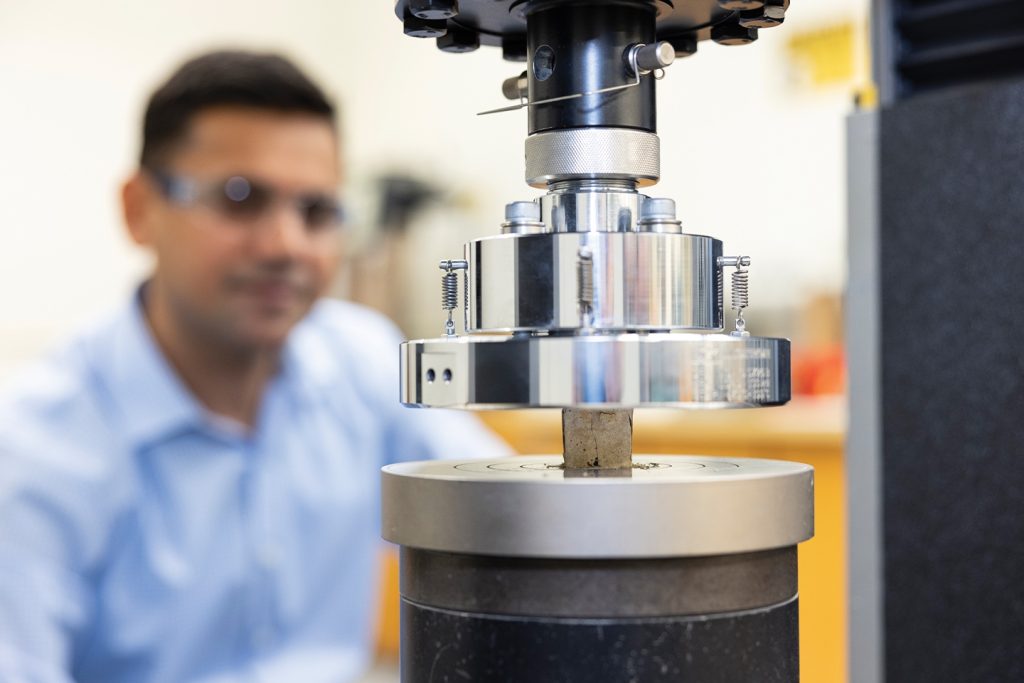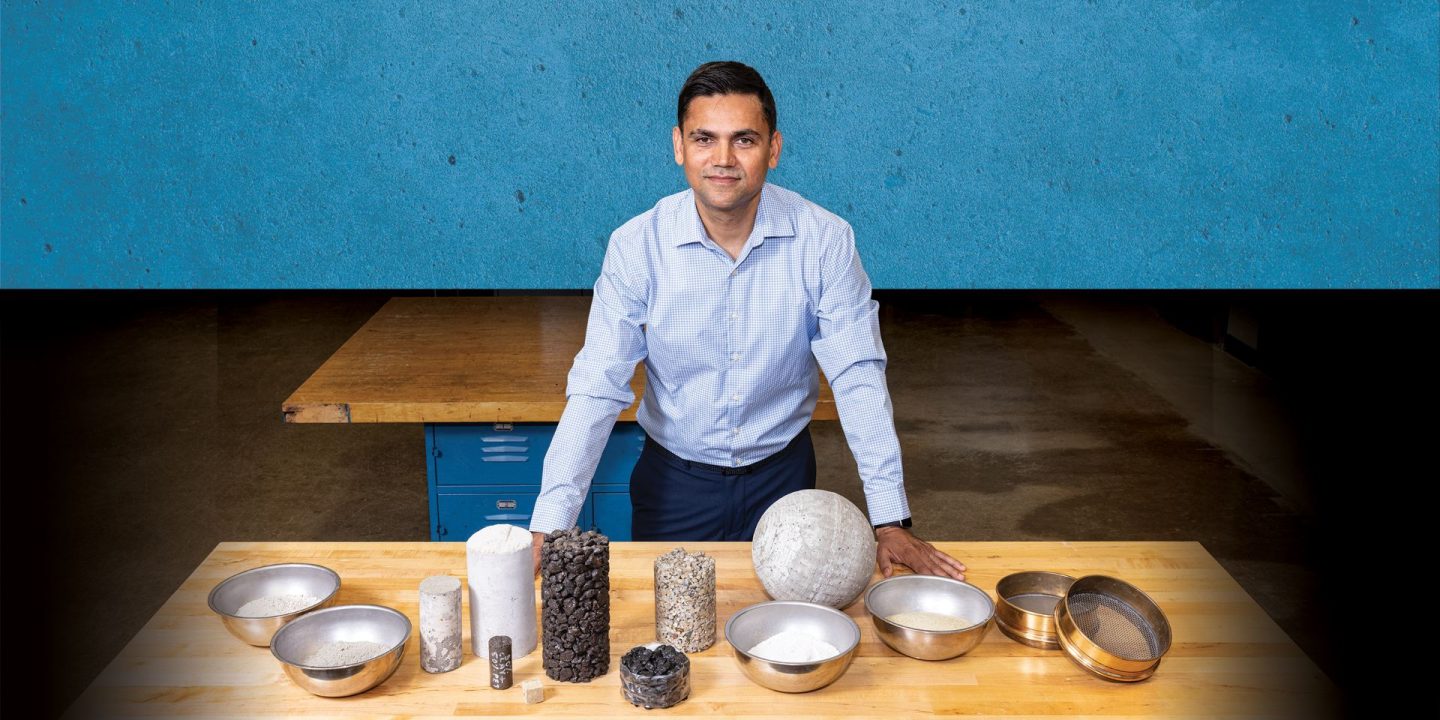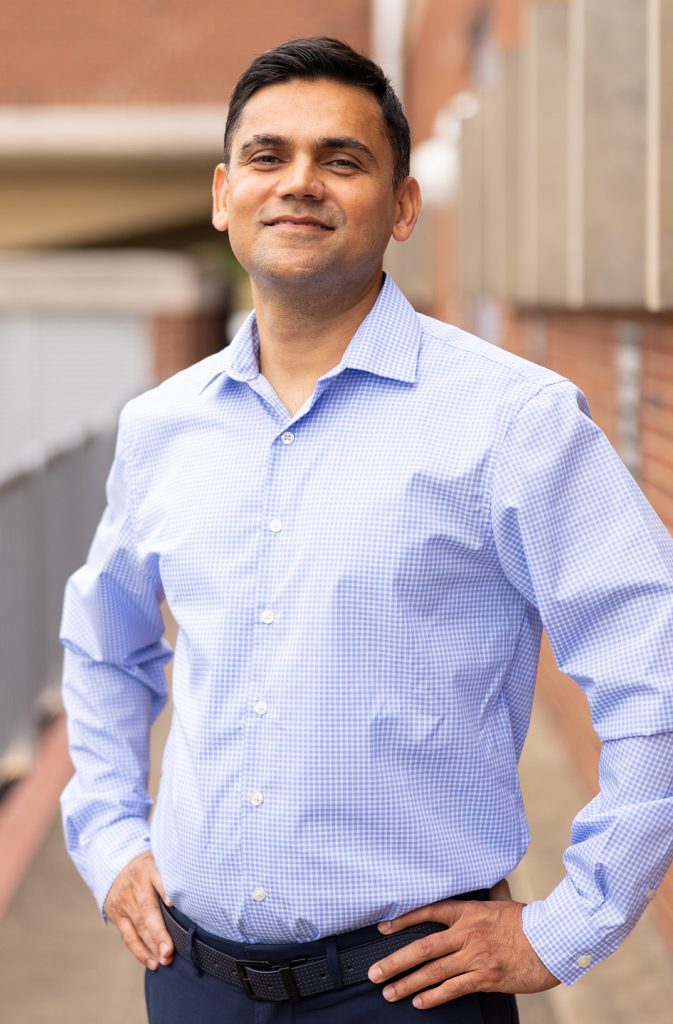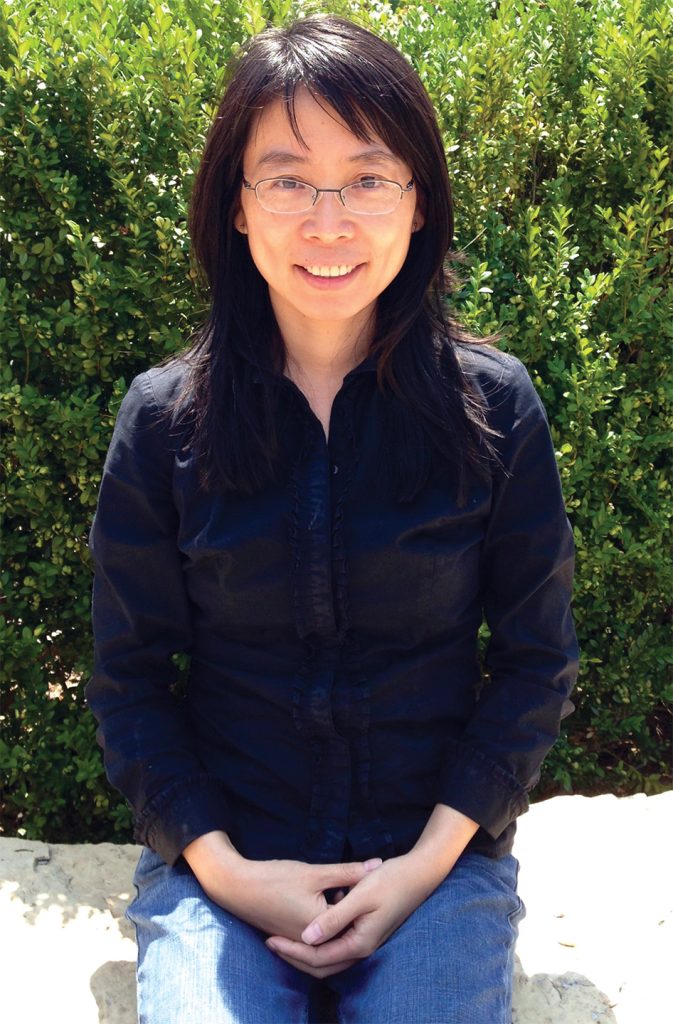Engineers are among the world’s great problem-solvers. Dr. Pranshoo Solanki, a professor of technology and a civil engineer by training, is trying to find creative solutions for a complex problem with worldwide implications.
Since arriving at Illinois State in 2011, Solanki has been looking for new ways to use waste materials and industrial byproducts to achieve a higher degree of sustainability in construction materials. He has investigated using glass, plastic, fly ash residue from coal-burning power plants, tires, blast furnace slag from steel mills, rock quarry byproduct, and lake- and river-dredged sediment. His research with dredged materials has received funding from the National Oceanic and Atmospheric Administration, and his recycled glass research has been supported by the Environmental Protection Agency.
“My research theme is innovative construction materials and methodologies that can be used for building a sustainable infrastructure,” Solanki said. “Sustainable construction brings many benefits to our society, environment, and economy. It’s a research topic that is of national and international importance as growing demand and limited natural resources are increasing interest in sustainable construction materials and methods.”
One important way Solanki is seeking to make road construction materials more sustainable is by reducing the amount of cement used in concrete. Producing cement requires burning fossil fuels and a chemical reaction that releases carbon dioxide.
“To make concrete you need cement, which is the chemical binder, and sand, stone, and water,” Solanki said. “Cement manufacturing emits 8% of the planet’s carbon dioxide, which makes it a major contributor to worldwide greenhouse emissions. We are looking for alternatives to cement as well as sand.”
The Illinois Department of Transportation—which has also funded Solanki’s research—allows 25% of cement to be replaced with fly ash.
“Up to 25% fly ash substitution, and you gain strength, and the concrete will be better,” he said. “Chemically fly ash is not consistent from power plant to power plant. Also, thermal power plants are being closed, so there’s a limited supply of fly ash so we are looking for an alternative.”
Appears InCement is also expensive to make; therefore, using alternative materials could save money. For example, Solanki is using recycled glass to create a geopolymer concrete composed of activator solution made using recycled glass and industrial byproducts such as fly ash and slag. He has made it completely without cement, and his testing shows promising results, but challenges remain.
“One problem is that you need very high temperatures, and you can’t cure it in ambient air,” he said. “Now we are trying to make it at room temperature, in ambient air conditions, and we are getting strength equal to concrete. But we need to test it for long-term durability and see how it behaves in a freeze-thaw cycle.”
“Sustainable construction brings many benefits to our society, environment, and economy. It’s a research topic that is of national and international importance.”
Dr. Pranshoo Solanki
Solanki has deployed recycled plastic to create a pervious concrete that is used in the construction of surface parking lots. The advantage is that rain passes through Solanki’s concrete and returns to the water table rather than creating runoff. Other ingredients include fly ash and recycled tires but no cement.
In addition, Solanki developed a composite using plastic fused with clay. The resulting material was strong like concrete and contained no cement. Because of its moisture resistance, the composite can be used in areas exposed to rain and flooding.
Solanki frequently collaborates with Dr. Guang Jin, a professor of environmental health and sustainability at Illinois State. When Jin and Solanki work together, their respective roles are well defined: Jin works on the chemistry of the material while Solanki works on the mechanical performance of the material. Jin formulates a chemical using the recycled glass that Solanki uses to create geopolymer concrete specimens for testing.
Bloomington-Normal has a single-stream material recovery facility (MRF) that collects a lot of glass, which Solanki uses. That is almost a perfect match for the researchers, except that the local company barely breaks even financially on the glass portion of the business.
“Recycling glass sounds simple,” Jin said. “You melt it down and remake it into glass, but it’s not that simple.”
The recycled glass stream carries a lot of contaminants like small rocks, shredded papers, plastic debris, and labels that need to be removed. The glass must also be separated by color at a sorting facility before being remade into glass of various grades and colors. Those processes are costly, as is shipping the heavy glass to a Chicago recycler.
“The local MRF wants to stop accepting glass,” Jin said. “I’m looking for a market for it, so that the facility keeps taking it for recycling.”
Another example of the urgency of Solanki’s work is his use of dredged material, the excavated sediment from the bottom of lakes and rivers. He has tested dredged material dug from the bottom of the Illinois River near Peoria and from Lake Michigan. The U.S. Corps of Engineers annually dredges 200 million cubic yards of sediments to achieve greater depth at the bottom of the nation’s waterways to improve shipping transportation.
“Of that 200 million cubic yards, only 50 million cubic yards are recycled,” Solanki said. “That leaves 150 million cubic yards of dredged material that piles up each year, and it’s increasing.”
Solanki tests the recycled materials in the Construction Materials Lab in Turner Hall. He measures the tension and compression of the materials to see how much load they can handle before breaking, which is important to know if they are to be used for roads since they would have to handle 18-wheelers rolling over them day and night in all kinds of weather.
Solanki offers graduate and undergraduate students opportunities to assist in his research by evaluating materials or making and testing samples in the lab. Lucas Roslewski ’23, an undergraduate research lab assistant last school year who has since graduated, helped Solanki with all phases of the lab work.
A geography major, Roslewski landed the job last year when he was looking for summer work. It was a good match since he hopes to pursue a sustainability-related career. “It’s cool because I love doing sustainable work. This project really interested me because concrete is so common. It’s everywhere. It would be awesome if we could improve it to help the environment.”
One day last spring, Roslewski was testing slag samples on a hydraulic press. He mixed the slag with Jin’s recipe of ingredients and made small cube specimens of roadway material that were placed in an oven for curing. Solanki removed the cubes from the oven after 24 hours and let them cool another 24 hours before they were tested.
“That’s when I take the cubes and measure their dimensions,” Roslewski said. “We do length, width, height, and weight. Then I put a cube on the Universal Testing Machine to see how it performs.”
The maximum compressive load tested so far is 10,000 pounds per square inch (psi). Roslewski was working last winter when he hit the max on a sample. That was a good day.
“When we found one that we got up to 10,000 psi, I was like super-excited,” he said. “I went into (Solanki’s) office and said, ‘You’re going to love this.’”

You might say that Solanki keeps his eye on the road even when he’s not working. So much so that his wife has become accustomed to his travel habits.
“She knows that when we are driving, and we cross the border into a new state, I will have some comments about the feel of the new pavement we are driving on in that particular state,” Solanki said.
It’s not unusual for road surfaces to feel different under a vehicle’s wheels just after crossing into a nearby state. For example, roads in Kentucky may feel smoother than those in Illinois.
“They might have better climatic conditions there or a better mix of construction materials,” Solanki said.
With municipal waste in this country made up of about 4 to 5% glass, and with only 25% of that being recycled, it means there’s a lot of room for recycling. And with so much waste material to test, Solanki’s research journey rolls along on a nearly endless path.
Jin said their shared interest in sustainability and the fact that the work is meaningful and practical keeps them both going. As does the idea that any impact they make on a global problem would have local reverberations, with the local recycler being one example.
“This work cannot be done without Pranshoo,” Jin said. “Unless he does the work to make sure those materials are strong and durable, there’s not going to be a market for them. Plus, he’s a pleasure to work with.”



